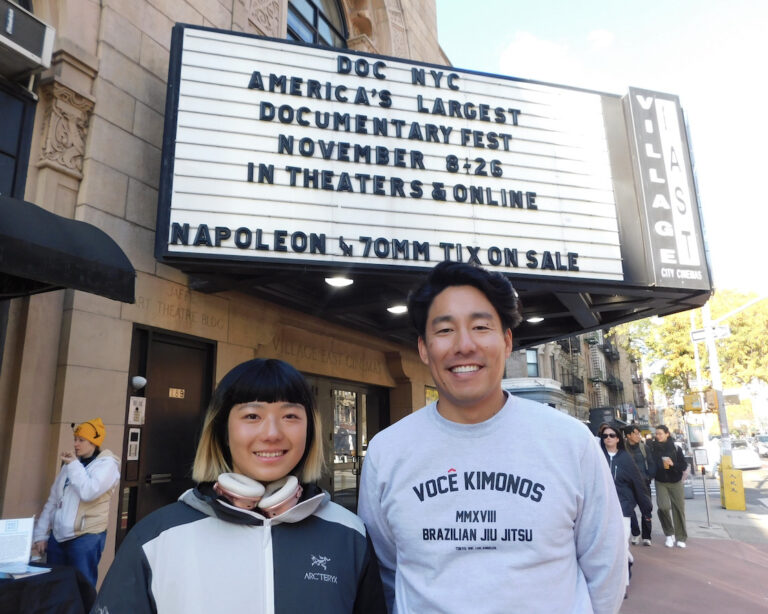
Synopsis : One of the world’s youngest elite rock climbers, Ashima Shiraishi spent her formative years breaking numerous age-based climbing milestones, spurred on by her number one fan and coach, her father, Poppo a retired Butoh dancer and avant-garde performer with no formal climbing experience. When these New Yorkers travel to South Africa to conquer a V14 boulder problem, father and daughter must face their interpersonal struggles in tandem with the challenging ascent.
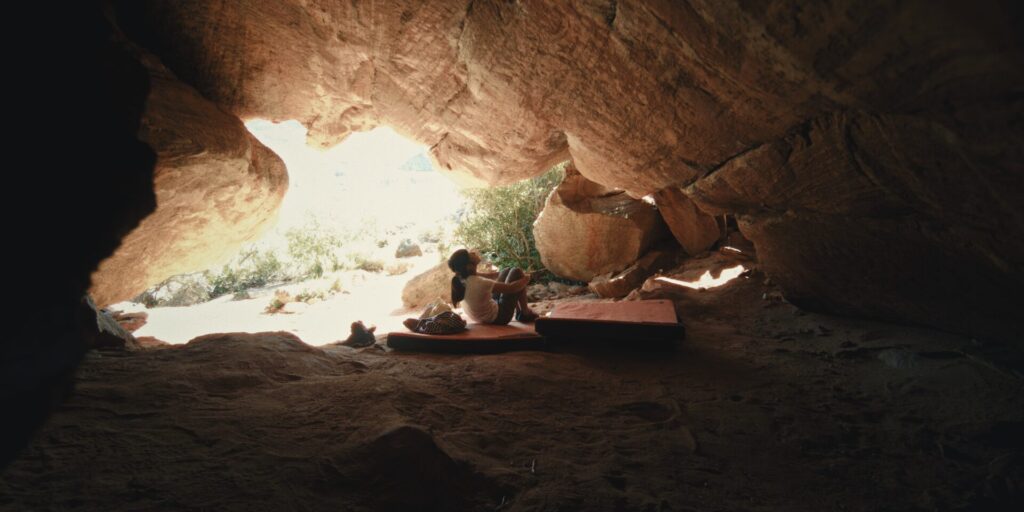
Q: How did you get to know Ashima in the first place? When did you decide to make this film since she started off at such a young age? How did you decide to make a movie together?
Kenji Tsukamoto: I worked for a company called Camp Four Collective. It was started by Jimmy Chen. Jimmy Az Turk and Tim Kemple. Right before I started working for them, I did a short documentary about Japanese American internment and that won an award but you can’t see it anywhere. It ran on a local PBS station. It’s called “Beehive Stories.” It’s part of a series that highlights a person for every county in Utah. They had me do Millard County, which is where Topaz internment camp was. I had family that were turned into Topaz. They had me direct that episode.
Q: I remember seeing the one with Star Trek’s George Takei, a documentary about him — he was doing an advert for that.
Kenji Tsukamoto: There’s so many documentaries on it. It’s like one of many, it did really well. It won an award. I think it was Tim who said, “Hey, if you want to tell more Asian-American or Japanese-American stories…” He told me, “I filmed this girl named Ashima. You should look into her.” I watched some of the footage that Tim shot and then looked up Ashima’s parents in the New York City, I called them and they invited me to come visit during Thanksgiving — Ashima’s Thanksgiving break. I think she was 11 at that time. We spent the whole week together just hanging out. At first, I thought about doing a short film, but it made me want to try and shoot a feature length film.
Q: As soon as you knew about the difficulty in the sport, you knew you had a story. They have a grade measurement for the difficulty of the boulder climb. Explain it to someone who doesn’t understand what the grading system means.
Ashima Shiraishi: Basically there’s a scale that ranges from V zero, which is the easiest and then currently VV zero is like, you can do that in one of those playgrounds that they set up — climbing for a beginner or something that’s like a V or it depends on the gym, but usually it’s V zero. If it’s your first time climbing, you could probably get up there. So, it’s something that’s kind of like a ladder. Then as you go up the grades, like V zero to V four is beginner and then V 4 to V 7 is intermediate and V 7 to V 11 might be considered advanced. V 11 to V 17 would be the professional level.
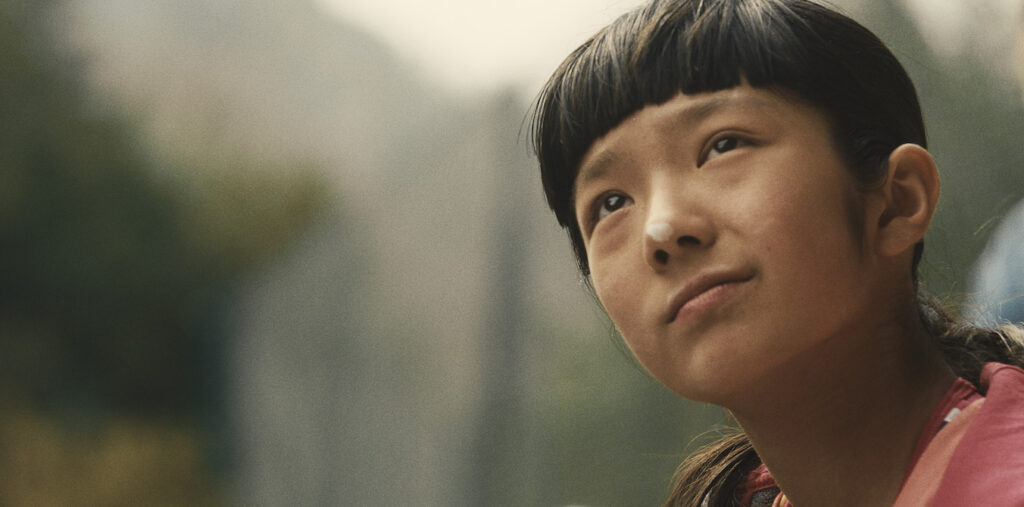 @Photo : Keniji Tsukamoto : Ashima studying a claims in Spain.
@Photo : Keniji Tsukamoto : Ashima studying a claims in Spain.
Q: At what point, did your parents decide to let you tackle the higher difficulty climbs? Talk about your relationship with your father? What was it like when you started climbing and how did it grow over the course of years?
Ashima Shiraishi: I think my dad and I have always been really close. He took on the role of my caretaker when I was born. My mom was working and supporting the family. He was always by my side, like a companion, but also a mentor in many ways. I think as I started to climb more, his involvement in mentorship really developed from his past as a butoh dancer. He realized that a lot of what he learned from his dance career, he could pass on to me and I could apply it to my rock climbing. In that way, we formed a bond because of the mental barriers that I needed to transcend in climbing. He was my guide and my teacher in that way. I think that a lot of my creative agency that I use in climbing was definitely influenced by my dad because he taught me to really view rock climbing as a form of dance. It’s a blank canvas where you can make your own choreography. A lot of his background, like Zen teaching from butoh, he taught me a lot about mental fortitude and how I can use that in rock climbing.
Q: Did you feel pressure when you started off because he quit dancing to focus on your work? It pretty much depends on your skill set. Obviously you were at such a young age but did you feel a certain pressure to be a success, to make your father happy?
Ashima Shiraishi: Definitely. a lot of the movie is focused on that tension because there’s pros and cons to everything. I really am grateful for how much attention, care and love that I received from my parents. They care so much about how I do in life and my achievements and making sure that I’m living up to my full potential. At the same time, that comes with a lot of burdens of pressure to be the best and sometimes it is really unhealthy. It ebbs and flows but it’s something that’s constantly changing — the relationship between my parents. It’s something that you have to deal with your whole life as your relationship changes throughout different phases. It never ends from childhood into adulthood.
Q: Obviously the story was to focus on Ashima, but how did you decide how much of her father’s Butoh background be included in this documentary?
Kenji Tsukamoto: We received a lot of old tapes from Ashima’s parents, a lot of dancing, some of it’s pretty intense and we wanted all ages to be able to watch this film. The main focus was more leaning towards Ashima’s side of the story. In terms of focusing on Butoh and that background, as Asian American kids, we can all see ourselves in Ashima and have that tension with our parents. It just comes innately with our shared experience, and even if you’re not Asian American, we all have relationships with our parents that are complex. I figured people will just project their own experiences onto that relationship whether it’s the immigrant family experience that Ashima has or not. I would just let that be, but there could be a whole documentary just made about that.
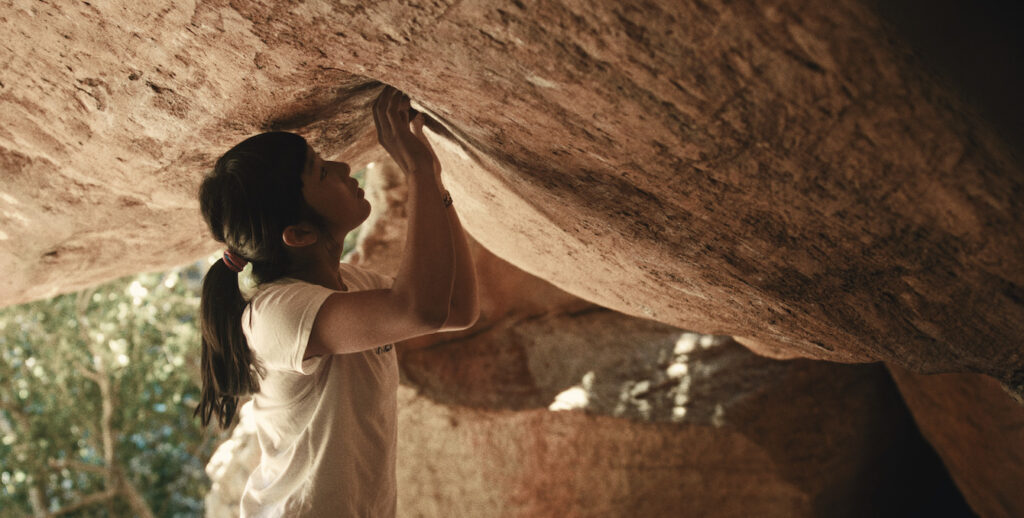 @Photo : Kenji Tsukamoto : Ashima Studying a Climb in Rocklands, South Africa
@Photo : Kenji Tsukamoto : Ashima Studying a Climb in Rocklands, South Africa
Q: What kinds of sponsorship and support did Ashima receive?
Kenji Tsukamoto: Ashima had some sponsors when I first met her, she had Adidas. After I met Ashima, I helped them get sponsorship from other outdoor brands. I’m not going to mention them because they’re not her current sponsor, but there were other brands that came and helped in terms of travel. But a lot still came from sacrifices that her mother made. Before that, there was a lot from her mother or local community, people helping out, climbing gyms, allowing her to climb there. When you were growing up, you didn’t pay for memberships, right? They just let you climb. So a lot of it is the climbing community helping out and then her mom working. It was a mix of both in terms of finding community.
Q: Could you talk about practice with Chris Sharma? It’s important to harbor some kind of mentor besides the family sometimes because they give you a certain perspective. So talk about the relationship, working with Chris Sharma.
Ashima Shiraishi: Chris Sharma was always one of my icons and heroes growing up. So it was very surreal to be climbing on the same wall and share a presence with him. it was unfathomable, like when I was first climbing. That was all a shock to me when we first started to have that conversation. Sharma is someone who I still look up to today, because he’s very humble and a really awesome human being. He is an icon in the climbing world. In general, I’m just really lucky to be able to be part of the climbing community because there is a diversity in terms of the characters and like different human beings who are to take part in the community and you get to learn so much through them and also build so many friendships along the way.
Q: When you are competing at such a young age, was it difficult to make friends amongst your competitors? Talk about how tough it was for you to grow up. Your father was your friend but did you have any friends your same age? how tough was it for you to grow up under those particular circumstances in a way.
Ashima Shiraishi: It is an interesting dichotomy that I grew up that way because my parents really pushed me to excel in one thing that was climbing, that was like my specialty. And then like being at the top of that field isolates you and especially because I wasn’t part of a team and I was climbing independently. Yeah, it was really hard because everything that I cared about was climbing and then it was hard to keep things in balance, the ups and downs and being able to face defeat. It was hard because there weren’t like other pillars through which my sense of purpose and meaning were reliant upon. I’m still trying to build that balanced architecture today because it’s really a necessity to make sure that you are a resilient and adaptable human being. But when you put all of your eggs in one basket, it’s hard to go through challenges and hurdles.
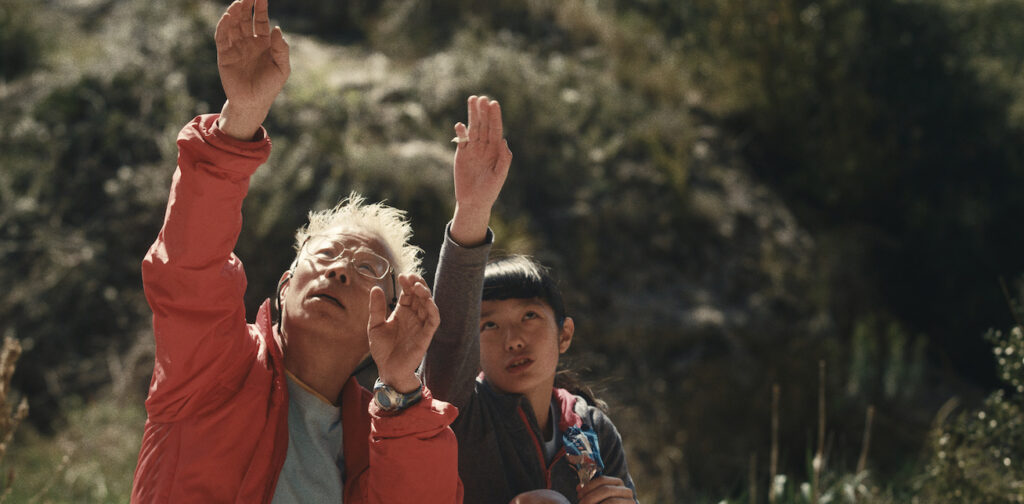 @Photo by Kenji Tsuykamoto : Ashima & Poppo studying a Climb in Spain
@Photo by Kenji Tsuykamoto : Ashima & Poppo studying a Climb in Spain
Q: That’s so true. Talk about your relationship with your mother because she had you 10 years after your father and mother got together. They were young and were happy, Right?
Ashima: They were actually 15.
Q: Can you talk about your relationship with your mother? often, when you were away competing, you spoke with her over the phone. She was probably the most caring person to you. Talk about the relationship with your mother and it helped you during competitions.
Ashima Shiraishi: It was inevitable but something that’s a source of some sadness. I wasn’t able to have much of a relationship with my mom because she was always busy and working. My mother has always been someone that I’ve been so fascinated by and inspired by because she is a powerful figure in our family and she makes the money. She does all the finances. She’s so competent in a lot of things and really smart. I really looked up to her in a lot of ways. But at the same time, I feel more [connected] to my dad because he is very much an artist and thinks in abstract and more philosophical ways. I feel more similar to him probably because I grew up just being next to him rather than my mom since he had more of a role raising me.
Q: How did you gather the archive footage of the competitions?
Kenji Tsukamoto: I lived with them on and off for a few years so I filmed all that. I lived in a little room above their home, like a storage closet up there. I was there on and off. I went back between where I’m based in Utah to where Ashima is in New York City. From like the time she was 11 – 13, I was always around. And we traveled together. We traveled to Texas together and Spain, all the different places and it helps that I can drive too. When we travel, I would do the driving. There’s some media when she’s really young, climbing in Central Park — things like home video. Her family let me use the photographs, but the rest of the stuff is all things that I filmed just being around with a camera.
Q: It doesn’t seem like you missed anything there. There’s a lot of footage of Ashima reading, doing homework, etc. Talk about how you managed the schooling and homework while you were competing with others. Talk about the challenge and how you were able to manage the footage of all the schooling and competition.
Ashima Shiraishi: I had a really strict schedule. I would wake up at seven, go to school, get out at like 4 p.m., go climbing, do homework, go to bed at like one and was definitely asleep at five. I had no time to do anything else. I did two things. It was school and it was climbing and that was it. I didn’t have time to socialize or pursue other interests.
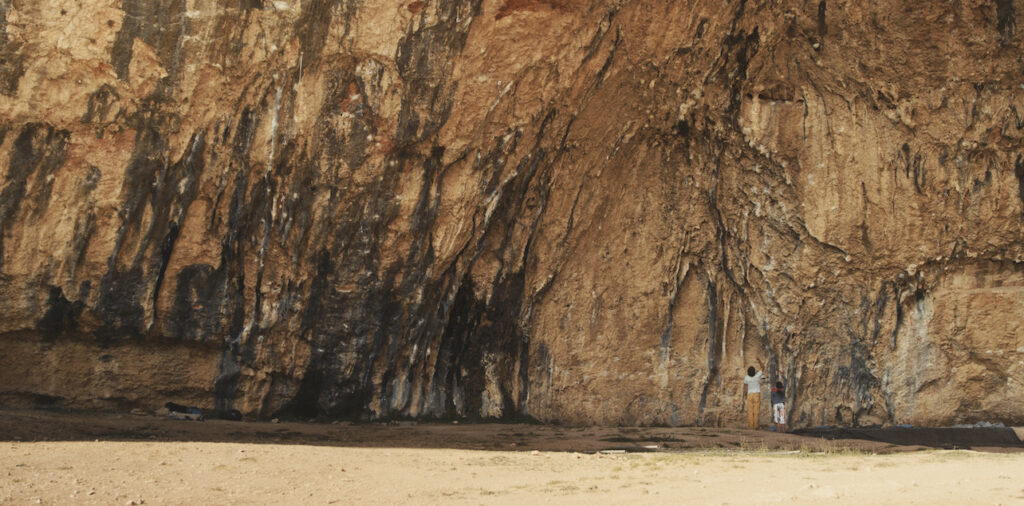 @Photo by Kenji Tsukamoto : Ashima & Chris in Spain
@Photo by Kenji Tsukamoto : Ashima & Chris in Spain
Q: That must be really tough. But at the same time, that pays off. How was your experience so far being in NYC and showing your doc here because this is one of the most prestigious documentary festivals in North America. Talk about being here– seeing and showing the film here.
Kenji Tsukamoto: So far the experience has been great, meeting other filmmakers and people that put together the festival. They’ve been very welcoming. The opening night film was about someone from Fukushima in Japan. It was great because Ashima’s mom is from Fukushima. I was trying to see that, but they haven’t sent me the screener so I haven’t seen it yet. It’s been a wonderful experience in terms of our film.
Q: How about you being here?
Ashima Shiraishi: This is where I grew up and I haven’t really taken part in any of the first days. I’m really excited for my friends and parents to see it.
Q: What do you want the audience to take away from this film?
Kenji Tsukamoto: This has so many messages. There’s so many different ways to view the film. I haven’t really thought that much about the audience. Ashima just saw the film like last week. My biggest thing was that after Ashima watched it, she felt like I for years that she let me just point the camera at her face that she felt that it was, that was worth it. That’s been my main focus. But with the audience too, I hope there’s so many people that have questions about Ashima that they see her on youtube or Instagram whenever we travel.
Young Asian American girls would come up to Ashima and be like, oh my gosh, you’re Ashima. I saw you on youtube, you got me climbing. So I hope this film shows a more intimate side of Ashima, not just like smiles and podiums and, and all this stuff, but the struggles that she went through too and, and the amount of Ashima is super smart, like doing homework.
A lot of the homework her parents couldn’t help her with. She did on her own, her English homework, all these things and the tenacity and just like the sheer effort she puts in everything that she does. the mental fortitude to overcome these challenges. I hope people see that side of her. It’s so impressive. Like in the film, the fact that she has that when she’s 13 is mind blowing. It’s historic of her basically, of how awesome she is. That’s what they’ll come away with.
Ashima Shiraishi: It’s more like a really beautiful gift to the world of my parents. You see so much of my parents that gets cut off from the media. I’m a product of a lot of people helping me and my parents who are a huge support in that network. I really love how the film portrays my parents. There’s a lot of nuance in our family dynamics. But there’s also the painful parts, and the joyfulness of it as well.
It captures it well in terms of seeing both sides of it. All families are complex as Kenji said. I just hope that other people can relate to certain aspects of the film, not just the accolades or accomplishments in climbing, but to see some of the hardships as well — that it’s not always the ups. There’s plenty of times where I felt completely gutted and felt like giving up.
Q: I forgot to ask — are you able to compete in the Olympics sometime in the future?
Ashima Shiraishi: I don’t think so. I don’t think that competition climbing is something in the Games yet.
Our Review of the film, “Ashima.”

